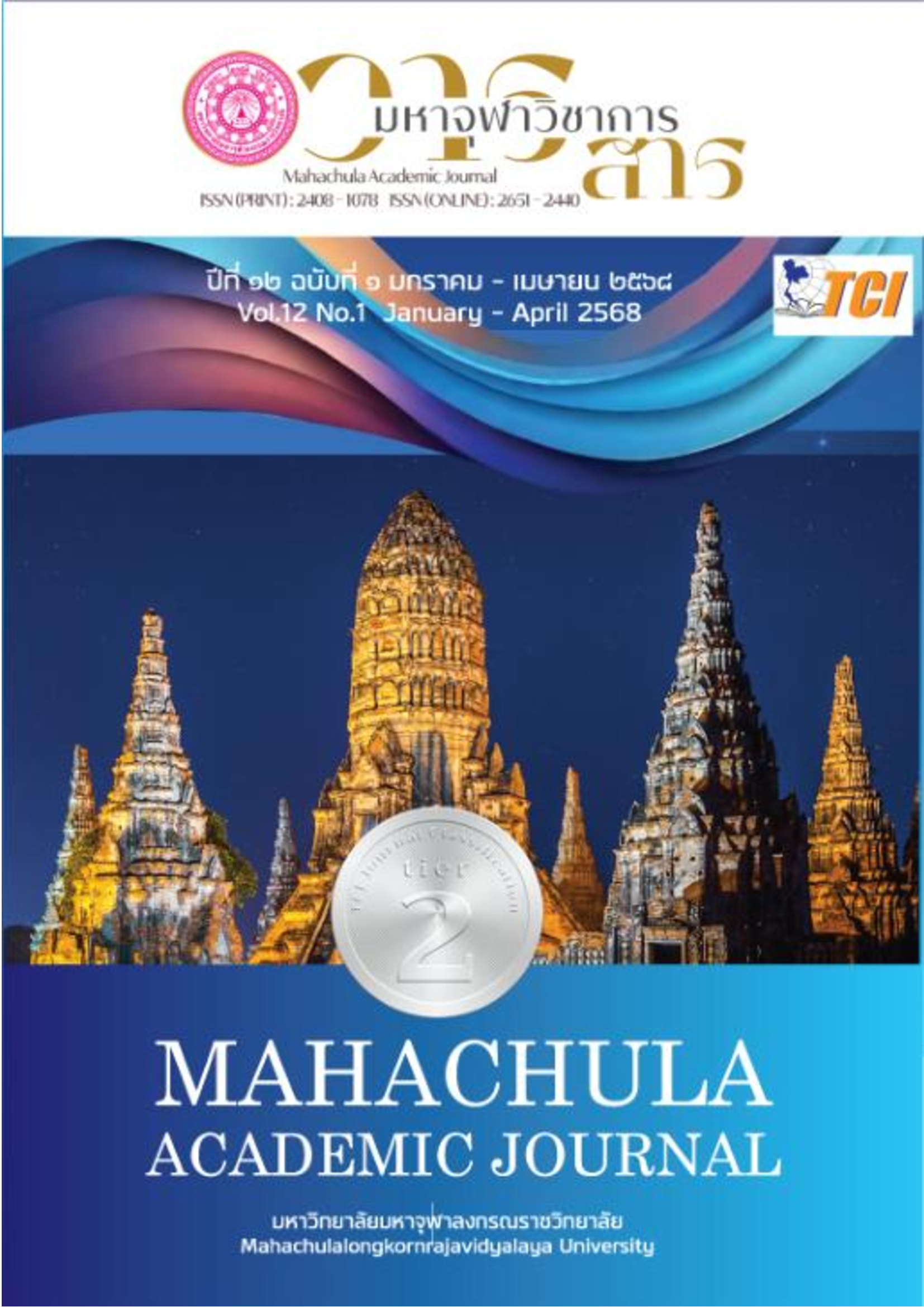การบูรณาการไตรสิกขาและแนวคิดจิตสาธารณะเพื่อส่งเสริมการอนุรักษ์สิ่งแวดล้อม
Main Article Content
บทคัดย่อ
บทความวิชาการนี้มีวัตถุประสงค์เพื่อบูรณาการไตรสิกขาและแนวคิดจิตสาธารณะสำหรับส่งเสริมการอนุรักษ์สิ่งแวดล้อม ศึกษาค้นคว้าข้อมูลเกี่ยวกับไตรสิกขาและแนวคิดจิตสาธารณะจากตำรา หนังสือ งานวิจัยที่เกี่ยวข้อง แล้วบูรณาการไตรสิกขาและแนวคิดจิตสาธารณะตามวิธิบูรณาการที่ ๒ คือ การปรับหลักพระพุทธศาสนาเข้าหาศาสตร์ตามแนวคิดของพระพรหมบัณฑิต (ประยูร ธมฺมจิตฺโต) ผลการบูรณาการทำให้ได้ “MSMW Model” เพื่อการส่งเสริมการอนุรักษ์สิ่งแวดล้อม ประกอบด้วย M = Moral Behavior (พฤติกรรมทางศีลธรรม) การมีพฤติกรรมที่ประกอบด้วยศีลธรรม ไม่เบียดเบียนสิ่งแวดล้อมทางธรรมชาติและสิ่งแวดล้อมที่มนุษย์สร้างขึ้น การใช้ทรัพยากรอย่างชาญฉลาดและยั่งยืน S = Social Responsibility (ความรับผิดชอบต่อสังคม) การไม่สร้างความเดือดร้อนต่อสังคมและสิ่งแวดล้อม การทำงานร่วมกับผู้อื่นในสังคมอย่างมีความรับผิดชอบ M = Moral Mind (จิตใจอันประกอบด้วยคุณธรรมจริยธรรม) การมีจิตใจที่มีคุณธรรมจริยธรรม มีความเมตตากรุณาและมุ่งมั่นในการพิทักษ์รักษาสิ่งแวดล้อมให้คงอยู่ตราบนานเท่านาน W = Wisdom (ปัญญา) การมีปัญญาในการอนุรักษ์สิ่งแวดล้อม การคิดค้นแนวทางใหม่ๆ ในการอนุรักษ์สิ่งแวดล้อมอย่างต่อเนื่อง การนำ MSMW Model มาปฏิบัติจริงจะส่งเสริมการอนุรักษ์สิ่งแวดล้อมอย่างยั่งยืน ทั้งในด้านพฤติกรรม จิตใจ และการใช้ปัญญาเพื่อคิดค้นและพัฒนาแนวทางที่มีประสิทธิภาพในการรักษาสิ่งแวดล้อมและสังคม
Article Details

อนุญาตภายใต้เงื่อนไข Creative Commons Attribution-NonCommercial-NoDerivatives 4.0 International License.
เอกสารอ้างอิง
กรกมล ชูช่วย. ทรัพยากรธรรมชาติและสิ่งแวดล้อมในท้องถิ่น. วิทยาศาสตร์สิ่งแวดล้อม คณะครุศาสตร์:มหาวิทยาลัยราชภัฏสวนสุนันทา, ๒๕๖๕.
กรรยา พรรณนา. จิตสาธารณะสร้างได้ง่ายนิดเดียว. กรุงเทพมหานคร: สำนักพิมพ์แห่งจุฬาลงกรณ์มหาวิทยาลัย, ๒๕๕๙.
ชัยวัฒน์ สุทธิรัตน์. สอนเด็กให้มีจิตสาธารณะ. พิมพ์ครั้งที่ ๖. กรุงเทพมหานคร: บริษัท วี พรินท์, ๒๕๖๑.
ปัญญา รุ่งเรือง. “จิตสาธารณะ: แนวคิดพนฐานและการจัดการเรียนรู้เพื่อพัฒนาและปลูกฝังจิตสาธารณะให้แก่ผู้เรียน”. งานประชุมวิชาการระดับชาติครั้งที่ ๑๑ มหาวิทยาลัยราชภัฏนครปฐม. (๑๑-๑๒ กรกฎาคม ๒๕๖๒): ๑๕๑๓.
พระธรรมโกศาจารย์. วิธีบูรณาการพระพุทธศาสนากับศาสตร์สมัยใหม่่. พระนครศรีอยุธยา: โรงพิมพ์มหาจุฬาลงกรณราชวิทยาลัย, ๒๕๕๓.
พระธรรมโกศาจารย์. วิธีบูรณาการพระพุทธศาสนากับศาสตร์สมัยใหม่่. ม.ป.ท.: ม.ป.พ., ๒๕๕๓.
มหาจุฬาลงกรณราชวิทยาลัย. พระไตรปิฎกภาษาไทย ฉบับมหาจุฬาลงกรณราชวิทยาลัย. กรุงเทพมหานคร: โรงพิมพ์มหาจุฬาลงกรณราชวิทยาลัย, ๒๕๓๙.
วิบูลย์พงศ์ พันธุนนท์. “ไตรสิกขากับการบรรลุธรรมในคัมภีร์พระพุทธศาสนาเถรวาท”. วิทยานิพนธ์พุทธศาสตรมหาบัณฑิต สาขาวิชาพระไตรปิฎกศึกษา. บัณฑิตวิทยาลัย: มหาวิทยาลัยมหาจุฬาลงกรณราชวิทยาลัย, ๒๕๖๑.
สมเด็จพระพุทธโฆษาจารย์ (ป. อ. ปยุตฺโต). จะพัฒนาคนกันได้อย่างไร?. พิมพ์ครั้งที่ ๑๕. ม.ป.ท.: ม.ป.พ., ๒๕๖๗.
สมเด็จพระพุทธโฆษาจารย์ (ป. อ. ปยุตฺโต). ชีวิตที่เป็นอยู่ดี: ด้วยมีการศึกษาทั้ง ๓ ที่ทำให้พัฒนาครบทั้ง ๔. พิมพ์ครั้งที่ ๔. กรุงเทพมหานคร: บริษัท ธรรมสภา บันลือธรรม จำกัด, ๒๕๕๕.
สมเด็จพระพุทธโฆษาจารย์ (ป. อ. ปยุตฺโต). พุทธธรรม ฉบับปรับขยาย. พิมพ์ครั้งที่ ๕๑. กรุงเทพมหานคร: โรงพิมพ์ สหธรรมิก จำกัด, ๒๕๖๒.
สุภาภรณ์ พรหมนา. “จิตสาธารณะการอนุรักษ์สิ่งแวดล้อม”. วารสาร มจร การพัฒนาสังคม. ปีที่ ๒ ฉบับที่ ๓ (กันยายน-ธันวาคม ๒๕๖๐): ๔๓.
สุรพล ไกรสราวุฒิ. ไตรสิกขา: ระบบการศึกษาของพระพุทธเจ้า. กรุงเทพมหานคร: โรงพิมพ์แห่งจุฬาลงกรณ์มหาวิทยาลัย, ๒๕๖๐.


